WORKED PROBLEMS
WORKED PROBLEMS
Problem 1
In Drosophila melanogaster, forked bristles are caused by an allele (Xf) that is X linked and recessive to an allele for normal bristles (X+). Brown eyes are caused by an allele (b) that is autosomal and recessive to an allele for red eyes (b+). A female fly that is homozygous for normal bristles and red eyes mates with a male fly that has forked bristles and brown eyes. The F1 are intercrossed to produce the F2. What will the phenotypes and proportions of the F2 flies from this cross be?
Solution Strategy
What information is required in your answer to the problem?
Phenotypes and proportions of the F2 flies.
What information is provided to solve the problem?
Forked bristles are X-
linked recessive. Brown eyes are autosomal recessive.
Phenotypes of the parents of the cross.
The F1 are intercrossed to produce the F2.
For help with this problem, review:
X-
Section 3.3 in Chapter 3.
Solution Steps
This problem is best worked by breaking the cross down into two separate crosses, one for the X-
Let’s begin with the autosomal characteristics. A female fly that is homozygous for red eyes (b+b+) is crossed with a male with brown eyes. Because brown eyes are recessive, the male fly must be homozygous for the brown-
Hint: For problems involving multiple loci, break the cross down into two separate crosses.

The F1 are then intercrossed to produce the F2. Whenever two individual organisms heterozygous for an autosomal recessive characteristic are crossed, ¾ of the offspring will have the dominant trait and ¼ will have the recessive trait; thus, ¾ of the F2 flies will have red eyes and ¼ will have brown eyes:
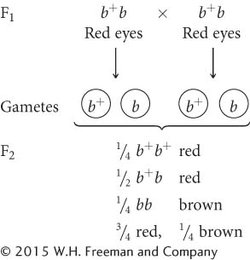
Next, we work out the results for the X-
Recall: Females have two X-

When these F1 are intercrossed, ½ of the F2 will be normal-
Recall: The multiplication rule states that the probability of two independent events occurring together is the multiplication of their independent probabilities.
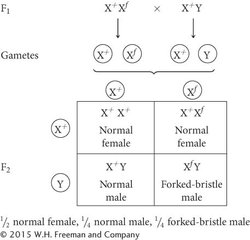
To obtain the phenotypic ratio in the F2, we now combine these two crosses by using the multiplication rule and the branch diagram:
Hint: The branch diagram is a convenient way of keeping up with all the different combinations of traits.
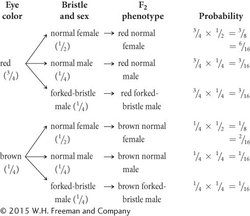
Problem 2
The type of plumage found in mallard ducks is determined by three alleles at a single locus: MR, which encodes restricted plumage; M, which encodes mallard plumage; and md, which encodes dusky plumage. The restricted phenotype is dominant over mallard and dusky; mallard is dominant over dusky (MR > M > md). Give the expected phenotypes and proportions of offspring produced by the following crosses:
MRM × mdmd
MRmd × Mmd
MRmd × MRM
MRM × Mmd
Solution Strategy
What information is required in your answer to the problem?
The phenotypes and proportions of progeny expected for each cross.
What information is provided to solve the problem?
Plumage in mallard ducks is determined by multiple alleles at a single locus.
Symbols for the alleles (MR, M, md).
Dominance relations among the alleles (MR > M > md).
Genotypes of the parents in each cross.
For help with this problem, review:
Multiple Alleles in Section 4.3.
Solution Steps
Hint: The Punnett square provides an easy way to determine the genotypes of the progeny of each cross.
We can determine the phenotypes and proportions of offspring by (1) determining the types of gametes produced by each parent and (2) combining the gametes of the two parents with the use of a Punnett square.
a.
Hint: The phenotypes of the progeny can be determined by looking at the dominance relations of the alleles in the progeny’s genotype.

b.
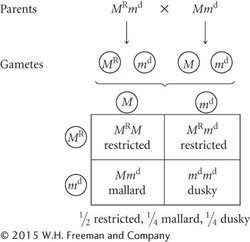
c.
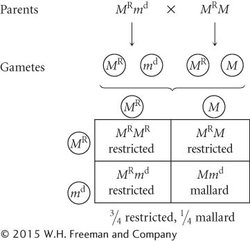
d.

Problem 3
In some sheep, horns are produced by an autosomal allele that is dominant in males and recessive in females. A horned female is crossed with a hornless male. One of the resulting F1 females is crossed with a hornless male. What proportion of the male and female progeny from this cross will have horns?
Solution Strategy
What information is required in your answer to the problem?
Proportions of male and female progeny that have horns.
What information is provided to solve the problem?
The presence of horns is due to an autosomal gene that is dominant in male and recessive in females.
A horned female is crossed with a hornless male. A resulting F1 female is crossed with a hornless male to produce progeny.
For help with this problem, review:
Sex-
Solution Steps
Hint: Write out the genotypes and the associated phenotype for each sex.
Recall: When a trait is dominant, both the homozygote and the heterozygote express the trait in their phenotypes.
The presence of horns in these sheep is an example of a sex-
| Genotype | Male phenotype | Female phenotype |
|---|---|---|
| HH | horned | horned |
| HH+ | horned | hornless |
| H+H+ | hornless | hornless |
In the problem, a horned female is crossed with a hornless male. From the preceding table, we see that a horned female must be homozygous for the allele for horns (HH), and that a hornless male must be homozygous for the allele for hornless (H+H+); so all the F1 will be heterozygous; the F1 males will be horned and the F1 females will be hornless, as shown in the following diagram:

A heterozygous hornless F1 female (H+H) is then crossed with a hornless male (H+H+):
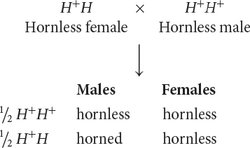
Therefore, ½ of the male progeny will be horned, but none of the female progeny will be horned.